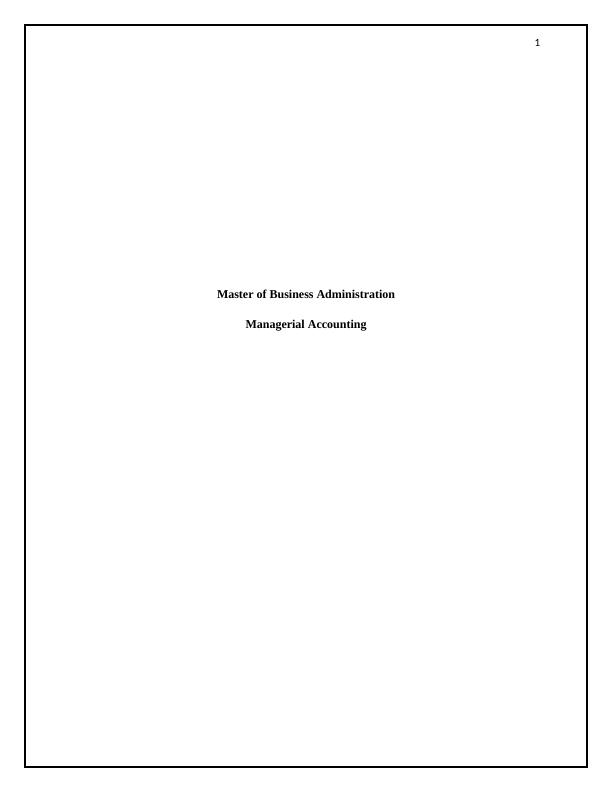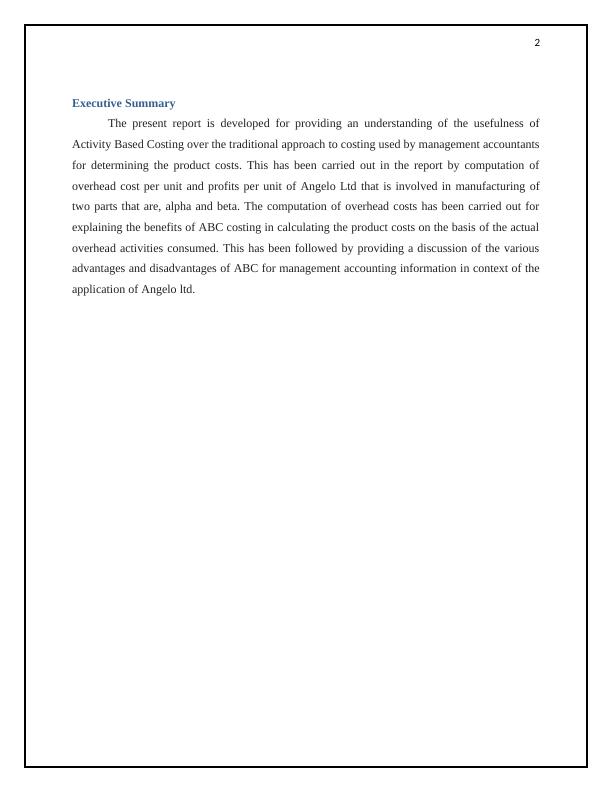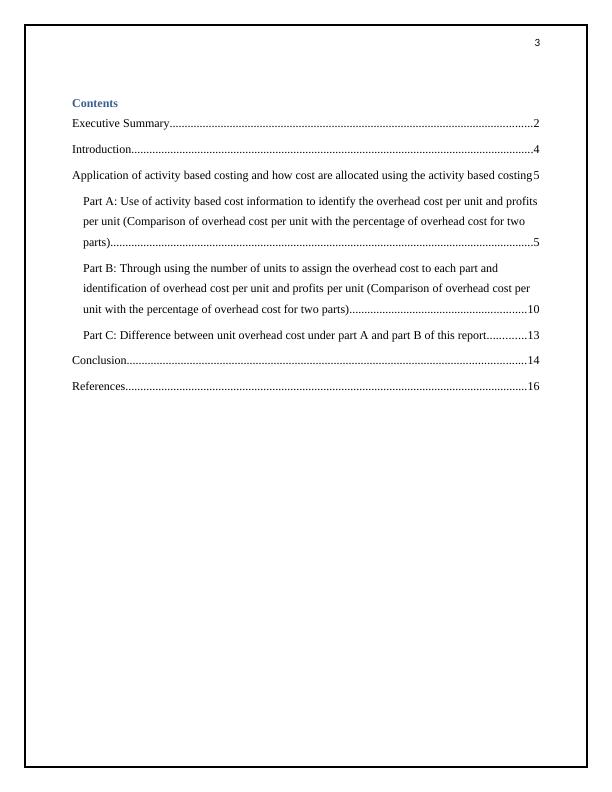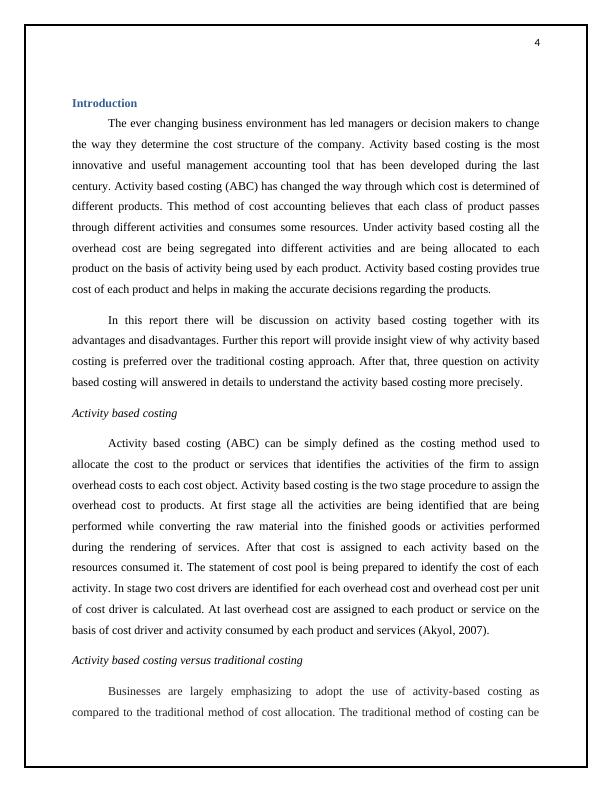Activity Based Costing vs Traditional Costing: A Case Study of Angelo Ltd
Added on 2023-06-04
17 Pages3841 Words397 Views
1
Master of Business Administration
Managerial Accounting
Master of Business Administration
Managerial Accounting

2
Executive Summary
The present report is developed for providing an understanding of the usefulness of
Activity Based Costing over the traditional approach to costing used by management accountants
for determining the product costs. This has been carried out in the report by computation of
overhead cost per unit and profits per unit of Angelo Ltd that is involved in manufacturing of
two parts that are, alpha and beta. The computation of overhead costs has been carried out for
explaining the benefits of ABC costing in calculating the product costs on the basis of the actual
overhead activities consumed. This has been followed by providing a discussion of the various
advantages and disadvantages of ABC for management accounting information in context of the
application of Angelo ltd.
Executive Summary
The present report is developed for providing an understanding of the usefulness of
Activity Based Costing over the traditional approach to costing used by management accountants
for determining the product costs. This has been carried out in the report by computation of
overhead cost per unit and profits per unit of Angelo Ltd that is involved in manufacturing of
two parts that are, alpha and beta. The computation of overhead costs has been carried out for
explaining the benefits of ABC costing in calculating the product costs on the basis of the actual
overhead activities consumed. This has been followed by providing a discussion of the various
advantages and disadvantages of ABC for management accounting information in context of the
application of Angelo ltd.

3
Contents
Executive Summary.........................................................................................................................2
Introduction......................................................................................................................................4
Application of activity based costing and how cost are allocated using the activity based costing 5
Part A: Use of activity based cost information to identify the overhead cost per unit and profits
per unit (Comparison of overhead cost per unit with the percentage of overhead cost for two
parts).............................................................................................................................................5
Part B: Through using the number of units to assign the overhead cost to each part and
identification of overhead cost per unit and profits per unit (Comparison of overhead cost per
unit with the percentage of overhead cost for two parts)...........................................................10
Part C: Difference between unit overhead cost under part A and part B of this report.............13
Conclusion.....................................................................................................................................14
References......................................................................................................................................16
Contents
Executive Summary.........................................................................................................................2
Introduction......................................................................................................................................4
Application of activity based costing and how cost are allocated using the activity based costing 5
Part A: Use of activity based cost information to identify the overhead cost per unit and profits
per unit (Comparison of overhead cost per unit with the percentage of overhead cost for two
parts).............................................................................................................................................5
Part B: Through using the number of units to assign the overhead cost to each part and
identification of overhead cost per unit and profits per unit (Comparison of overhead cost per
unit with the percentage of overhead cost for two parts)...........................................................10
Part C: Difference between unit overhead cost under part A and part B of this report.............13
Conclusion.....................................................................................................................................14
References......................................................................................................................................16

4
Introduction
The ever changing business environment has led managers or decision makers to change
the way they determine the cost structure of the company. Activity based costing is the most
innovative and useful management accounting tool that has been developed during the last
century. Activity based costing (ABC) has changed the way through which cost is determined of
different products. This method of cost accounting believes that each class of product passes
through different activities and consumes some resources. Under activity based costing all the
overhead cost are being segregated into different activities and are being allocated to each
product on the basis of activity being used by each product. Activity based costing provides true
cost of each product and helps in making the accurate decisions regarding the products.
In this report there will be discussion on activity based costing together with its
advantages and disadvantages. Further this report will provide insight view of why activity based
costing is preferred over the traditional costing approach. After that, three question on activity
based costing will answered in details to understand the activity based costing more precisely.
Activity based costing
Activity based costing (ABC) can be simply defined as the costing method used to
allocate the cost to the product or services that identifies the activities of the firm to assign
overhead costs to each cost object. Activity based costing is the two stage procedure to assign the
overhead cost to products. At first stage all the activities are being identified that are being
performed while converting the raw material into the finished goods or activities performed
during the rendering of services. After that cost is assigned to each activity based on the
resources consumed it. The statement of cost pool is being prepared to identify the cost of each
activity. In stage two cost drivers are identified for each overhead cost and overhead cost per unit
of cost driver is calculated. At last overhead cost are assigned to each product or service on the
basis of cost driver and activity consumed by each product and services (Akyol, 2007).
Activity based costing versus traditional costing
Businesses are largely emphasizing to adopt the use of activity-based costing as
compared to the traditional method of cost allocation. The traditional method of costing can be
Introduction
The ever changing business environment has led managers or decision makers to change
the way they determine the cost structure of the company. Activity based costing is the most
innovative and useful management accounting tool that has been developed during the last
century. Activity based costing (ABC) has changed the way through which cost is determined of
different products. This method of cost accounting believes that each class of product passes
through different activities and consumes some resources. Under activity based costing all the
overhead cost are being segregated into different activities and are being allocated to each
product on the basis of activity being used by each product. Activity based costing provides true
cost of each product and helps in making the accurate decisions regarding the products.
In this report there will be discussion on activity based costing together with its
advantages and disadvantages. Further this report will provide insight view of why activity based
costing is preferred over the traditional costing approach. After that, three question on activity
based costing will answered in details to understand the activity based costing more precisely.
Activity based costing
Activity based costing (ABC) can be simply defined as the costing method used to
allocate the cost to the product or services that identifies the activities of the firm to assign
overhead costs to each cost object. Activity based costing is the two stage procedure to assign the
overhead cost to products. At first stage all the activities are being identified that are being
performed while converting the raw material into the finished goods or activities performed
during the rendering of services. After that cost is assigned to each activity based on the
resources consumed it. The statement of cost pool is being prepared to identify the cost of each
activity. In stage two cost drivers are identified for each overhead cost and overhead cost per unit
of cost driver is calculated. At last overhead cost are assigned to each product or service on the
basis of cost driver and activity consumed by each product and services (Akyol, 2007).
Activity based costing versus traditional costing
Businesses are largely emphasizing to adopt the use of activity-based costing as
compared to the traditional method of cost allocation. The traditional method of costing can be

End of preview
Want to access all the pages? Upload your documents or become a member.
Related Documents
Activity Based Costing System PDFlg...
|17
|5216
|490
ACC200 Assignment on Overhead Costing and Activity Based Costinglg...
|13
|3018
|85
ABC v/s Traditional Costinglg...
|5
|790
|357
Report on Profitability of Essendon Electronicslg...
|10
|2617
|257
Activity Based Costing Of Rock Widget Organisationlg...
|19
|2699
|317
Production Cost within the Traditional Process - PDFlg...
|13
|1480
|18
